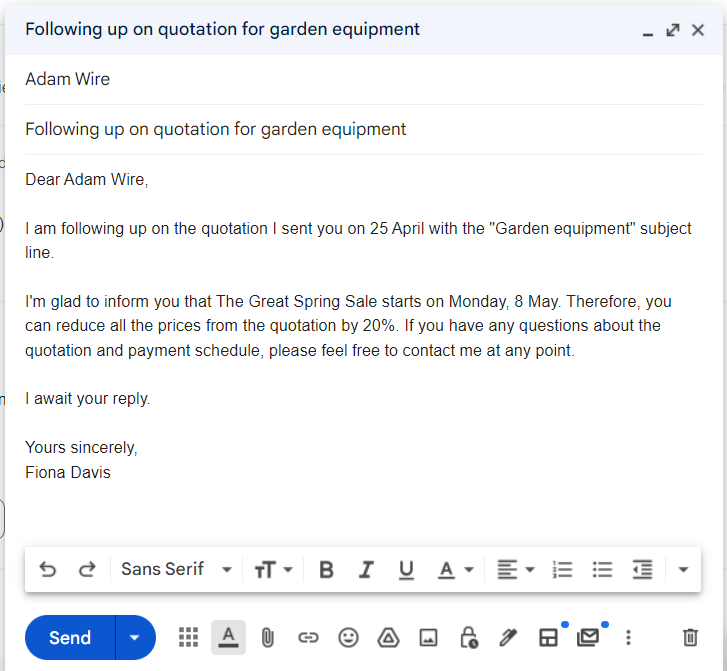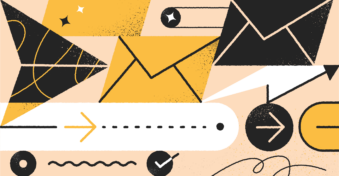We know how vital follow-up quotation emails are to a sales agent, as sometimes it’s the nudge a client needs to accept your deal. However, all sales agents walk a fine line between a nudge and a sledgehammer, so knowing how to approach the client after giving a quotation is critical.
Read this article further to find multiple tips on the best template when sending a quotation email sample and keeping track of these emails.
What Is a Quotation Email?
A quote email is when you’re sending a quotation to a client, stating how much a service or product will cost if they go ahead with the sale/order. It’s a preliminary offer usually valid for a specific amount of time and gives the client an idea of the possible costs their request will have.
Clients often request quotes from similar companies to get the best deal, so you must create a quotation email sample while keeping the competition in mind.
Why Is It Important to Follow Up Quotes?
A quotation follow-up email is a message sent to the client reminding them about the quote and offer while asking whether they want to go ahead with it. Generally, this follow-up email to the client after the quotation will offer them something to sweeten the deal.
It might be that your offer is a time-limited one, so this is the only chance they have to get it at a lower price. You might also offer a demo or a call with an expert to advertise your product or service.
A follow-up email for a quotation should always be sent after a few days, as people live a dynamic lifestyle, and it’s easy to forget something. Not only is it a payment reminder to the client, but also shows your company cares.
Tips for Sending a Quotation Reminder
We look at various tips you can use when writing the best sample email for sending a quotation to a client and creating an excellent follow-up quotation request email.
Tip 1: Do Your Research
Research into the client you sent a quotation mail might mean the difference between getting the deal or losing it. People like it when a company shows they care, and knowing the elements that might influence a client’s decision is vital.
Tip 2: Reference Your Previous Email
It’s always good to add a reminder about the previous email, as this allows the client to search for the email quotation. Add the date you sent it, possibly also the subject line, and offer to jog their memory.
Tip 3: Create a Stunning First Impression
The client’s first impression of your quotation reminder is not the body but the subject line. Create a killer line that’ll impress and create a memorable first impression.
Tip 4: Message Length
Any excellent email quotation format won’t be too long and will get to the point quickly. People don’t have the time to read a monologue, so keep it short and sweet, between 50 to 125 words.
Tip 5: Tone of Voice
The tone of voice is where the nudge or the sledgehammer comes into play, as your tone of voice can determine whether you sound like a professional or pushy salesperson. While you can add your personal flair, it’s best to ensure you always keep it professional and appropriate to the client you’re emailing.

Simple Way to Keep Track of Emails
We know how busy a sales agent can get. Managing multiple clients isn’t easy, and one might slip through the cracks. Using a Customer Relationship Manager (CRM) tool is vital to prevent that from happening. No more email campaigns running away from you or leads turning into nothing.
CRM tools effectively manage your emails, categorizing who you’ve sent email quotes to and who still needs contacting. Additional features are often available, like adding comments and notes on a client. These notes mean you can easily access and remember any special deals offered or previous sales.
A CRM tool, like the InboxCRM Chrome extension, will help you keep track of your follow-up quotes and emails. It can even send automatic follow-up quotation emails to ensure no client is forgotten and set reminders of meetings and deals.
Final Thoughts
Sending a quotation email to a client and following up on it ensures you make the most of your leads and don’t lose out on potential customers. However, we know it can become overwhelming, which is why we recommend you try using the free InboxCRM Chrome extension to help keep track of your email campaigns.
Track which clients have received a quote email and when you must send a reminder on that message. There’s no need to overwork yourself trying to keep up. Try out the InboxCRM Chrome extension and see how much easier your workload becomes.
FAQs
-
It’s relatively simple to send a quotation mail, provided you know the format. Many add the quotation as an attached document, which you should keep professional. Emailing quotes is the best option since it gives the client adequate time to consider it and ensures the offer is in writing.
-
The mail format for sending quotation emails is relatively simple. You must add your contact and tax information, the client’s details, and the product/service with the final pricing details. Ensure that all the required information is present, along with your payment details, reference number, and so on.
-
Sending a quote is a straightforward term, meaning you send a sales quote to a client. It lets the client know about any potential costs without the client committing to those costs. Since sending a quote isn’t synonymous with making the sale, a follow-up mail is often needed.


